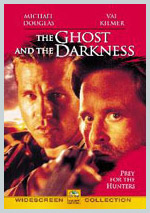|
Review added January 13, 2005.
The Ghost and the Darkness
:: DVD Review |
|
.
. |
|
|
|
| |
 |
|
|
Studio:
Paramount |
 |
>> Review
Equipment |
|
Video:
2.35:1 (Enhanced for 16:9) |
 |
Length:
105
Minutes |
|
Audio:
Dolby Digital 5.1 (384kbps) En/It |
 |
Subtitles: En/Fr/Gr/Heb |
|
Video Format:
PAL |
 |
Disc Format:
RSDL DVD-9
|
|
Layer Change:
63:31 |
 |
Disc Capacity Utilised:
6.08GB |
|
Average Bit-Rate (A+V):
7.74Mbps |
 |
Region Coding:
4 |
| |
|
|
|
|
|
|
.
. |
|
:: The Film
:: |
|
>> Skip to
Audio/Video Details
As they say, truth is often
stranger than fiction, and the The Ghost and the Darkness is
a case in point. The film is based on the notorious Tsavo
incident described in Lieutenant-Colonel John H. Patterson's
book 'The Man-Eaters of Tsavo'. Over a nine month period in
1898, a pair of rogue lions managed to kill 135 workers
constructing a bridge over Kenya's Tsavo River for the
British Trans African railway. The two lions proved so
elusive and difficult to kill the local Masai dubbed them
the Ghost and the Darkness, attributing them with
supernatural powers.
The story of the Tsavo Man-Eaters
was filmed previously as 'Bwana Devil' in 1952, and The
Ghost and the Darkness is a remake of sorts. Val Kilmer
plays Colonel John Patterson, an Irish engineer hired to
supervise the construction of a railway bridge across the
Tsavo River. Soon after his arrival, a pair of rogue lions
begin killing and eating workers constructing the bridge,
eventually causing construction to grind to a halt.
|
 |
|
After several failed attempts to kill the
lions, Patterson calls upon ex-patriot American hunter
Remington (Michael Douglas) to track and kill the lions, a
task that turns out to be much more difficult than either
anticipate. Val Kilmer is actually quite good here
(something I don't say very often), while Michael Douglas'
performance is adequate if a little over the top.
The film's direction is loose, with a big
ol' red herring thrown in for no reason but to annoy, and
the script has a few slow patches and plot-holes, but with
some dazzling cinematography and a bullet-proof premise this
turns out to be entertaining B-movie fare.
|
|
| ::
Video
:: |
.
. |

|
Although the disc's packaging states this is a 2.35:1
anamorphically-enhanced transfer, it looks much closer to
2.1:1. Luckily there doesn't appear to be any noticeable
loss of information on the sides of the frame. Since this
is a fairly recent film (1996) we should expect a nice
transfer, and generally speaking this is the case.
The Ghost and the Darkness is a very
cinematic film, with impressive vistas of dramatic African
landscapes, and excellent composition, all of which look
fabulous on this disc. The deep browns and greens of
Africa are cleanly rendered and look very nice indeed. On
the downside, the print used isn't as clean as would be
expected for such a recent production, with a few hairs,
scratches and general noise visible occasionally. The
image here is generally sharp, although at the expense of
some shimmer and aliasing, occasionally distractingly so.
There is also some edge enhancement evident: why disc
producers continue to think edge enhancement is required
on DVD is beyond me.
Blacks are a standout: deep and stable with
no noise, and fine detail is excellent, although this
detail retrieval often highlights film grain. Compression
artefacts are present, mainly in the form of motion blur,
but not serious and I didn't see any pixellation or image
break-up. This isn't a reference quality transfer, but is
still very good with no major problems, and a huge
improvement over its non-anamorphic R1 counterpart. Four
stars.
|
 |
|
.
. |
| :: Audio
:: |
.
. |
|

|
While the disc's transfer doesn't quite make superstar status,
the same can't be said of its Dolby Digital 5.1 soundtrack.
Being set in 19th century Africa, you might anticipate
opportunities for aural gymnastics to be limited, but you'd be
wrong. The designers of this soundtrack have taken every
opportunity to fully utilise their canvas, with discrete
effects appearing frequently and effectively from all channels
and a broad, constantly engaged front soundstage. One scene
involving lions attempting to break into a locked building
(65:00 on) is particularly impressive, with full use of all
channels and impressive 360-degree audio pans.
Dynamic range is very good, with the
film's score especially impressive, and very cleanly recorded
to boot. Deep bass is used sparingly but effectively to
reinforce the score and to punctuate gunshots, roaring lions
and the like, while dialogue is cleanly recorded and easy to
understand, although often obviously ADR produced. This is a
great soundtrack, earning four and a half stars.
|
 |
|
.
. |
|
|